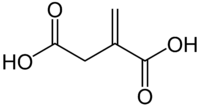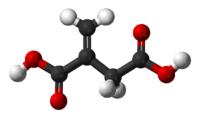Itaconic acid
 | |
 | |
| Names | |
|---|---|
| IUPAC name
2-Methylidenebutanedioic acid | |
| Other names
Methylenesuccinic acid;[1] 1-Propene-2-3-dicarboxylic acid | |
| Identifiers | |
| 97-65-4 | |
| ChEBI | CHEBI:30838 |
| ChEMBL | ChEMBL359159 |
| ChemSpider | 789 |
| |
| Jmol-3D images | Image |
| KEGG | C00490 |
| PubChem | 811 |
| |
| Properties | |
| Molecular formula |
C5H6O4 |
| Molar mass | 130.10 g·mol−1 |
| Appearance | White crystals |
| Density | 1.63 g/cm3[1] |
| Melting point | 162 °C (324 °F; 435 K) (decomposes)[1] |
| 1 g/12 mL[1] | |
| Solubility in ethanol | 1 g/5 mL[1] |
| Except where noted otherwise, data is given for materials in their standard state (at 25 °C (77 °F), 100 kPa) | |
| | |
| Infobox references | |
Itaconic acid, or methylenesuccinic acid, is an organic compound. Itaconic acid is a white crystalline powder. Itaconic acid is a naturally occurring compound, non-toxic, and readily biodegradable. The name itaconic was devised as an anagram of aconitic.
Historically, itaconic acid was obtained by the distillation of citric acid. Since the 1960s, it is produced industrially by the fermentation of carbohydrates such as glucose using Aspergillus terreus. As such, it is a fully sustainable industrial building block. It is primarily used as a co-monomer in the production of acrylonitrile-butadiene-styrene and acrylate latexes with applications in the paper and architectural coating industry.
Itaconic acid has in vitro activity against bacteria expressing the enzyme isocitrate lyase such as Salmonella enterica and Mycobacterium tuberculosis.[2]
References
- ↑ 1.0 1.1 1.2 1.3 1.4 Merck Index, 11th Edition, 5130
- ↑ . doi:10.1073/pnas.1218599110. Missing or empty
|title=(help)